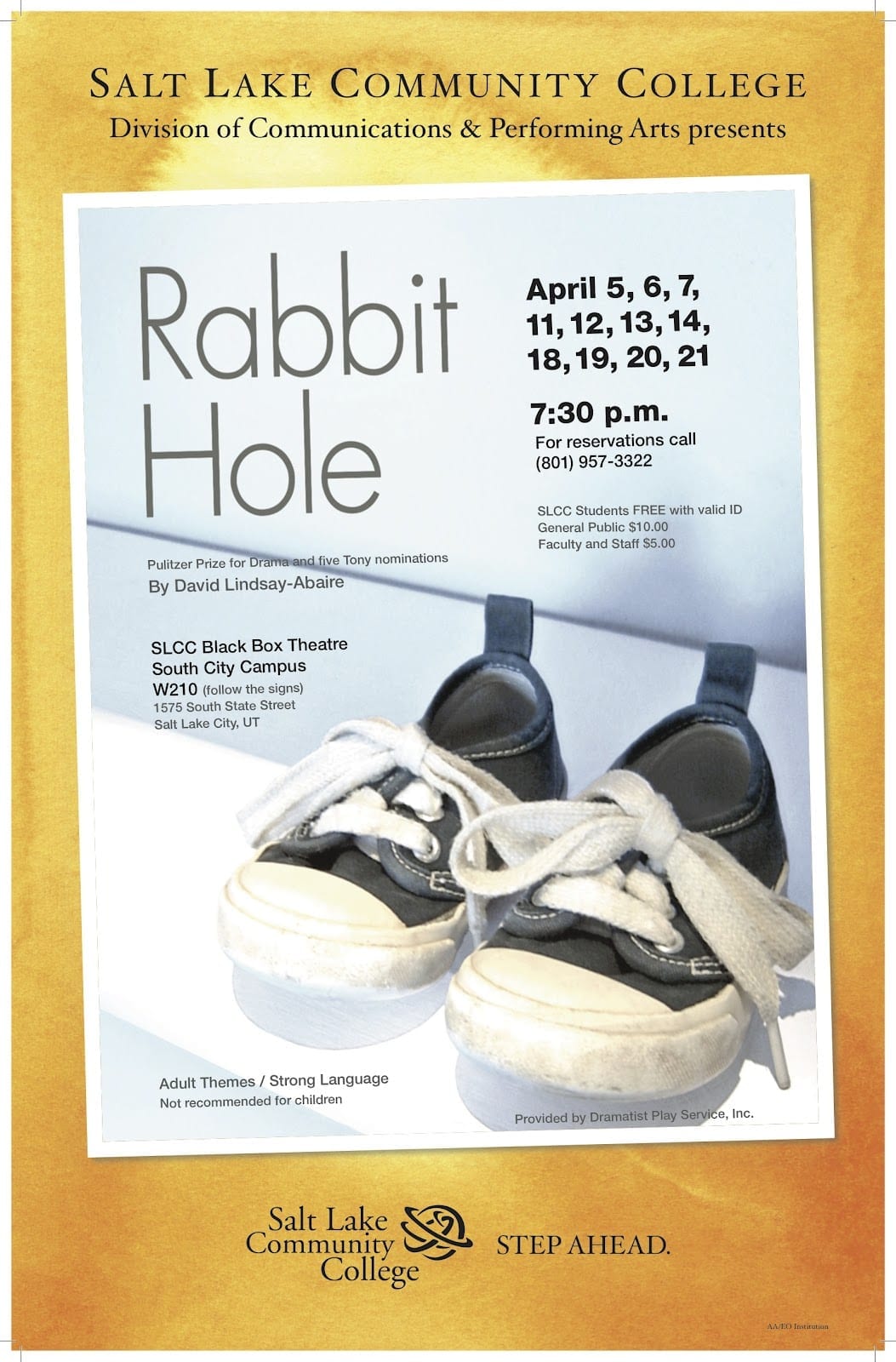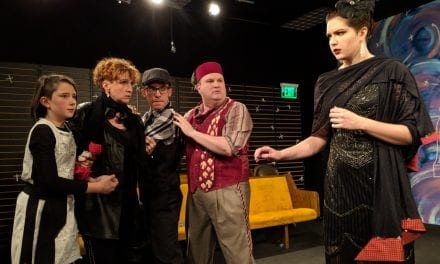PROVO — “How did you get to be here? What was the moment?” It’s normal from time to time for a person to look back on the life decisions that made them the person they are today. Maybe you do it every year as your birthday approaches; maybe the tendency to look back—sometimes with regrets, other times with relief—strikes you at unexpected times. For those attending Merrily We Roll Along at BYU, this self-reflection comes as part of a sensational night of theatre.
The story is a simple one: the friendship of three characters, Franklin Shepard, Charley Kringas, and Mary Flynn, grows, changes, and disintegrates because of the decisions they make. Frank especially is a man who—in his own words—always “said yes, when I meant to say no.” With this being a Stephen Sondheim show, however, the plot isn’t that simple. Merrily We Roll Along is unique because the story moves backwards. In other words, the first scene that the audience sees is, chronologically, the last scene of the story; each successive scene takes place before the events of the previous scene.
In addition to the structure of the play, there are many other elements that make Merrily We Roll Along a challenging show. One aspect is that the action takes place over the course of 19 years, and the major characters are seen as disenchanted middle aged people and also idealistic, naive young adults. This presents a major acting challenge that is only surpassed by a very small number of roles in the musical theater. I thought that, of the three lead actors, Briana Shipley (as Mary Flynn) was most up to the challenge. She convincingly played a loud, uninhibited alcoholic (in the first scene) and a caring, supporting best friend (in the chronologically earlier scenes, which are later in the play). Her passing through the various stages of Mary’s development was exciting to watch.
Woody White’s performance as Franklin Shepard (the main character in the play) took a little bit of warming up for me. In the opening two scenes, I didn’t see him as much of a greedy, materialistic phony. But once the character was in his early 30’s (roughly halfway through Act I), White won me over. White was especially believable as he interacted with the female characters in the play, and I thought that his introspective rendition of “Growing Up” was touching and revealed much of Franklin’s inner psychology. Peter Layland (as Charley Kringas) also took some getting used to for me, but the concern that his character showed for Frank after the latter’s divorce was genuine and heartwarming. After intermission, when the characters in the play were much closer to the actors’ real ages, White, Layland, and Shipley were an unstoppable trio as they made bold character choices (such as in their body language just before the wedding) and revealed information about their characters in inspired ways. Thanks to these three talented actors, I found it easy to fall in love with Frank, Mary, and Charley.
Although there are three main roles in this play, it’s clearly an ensemble piece. I thought that Kim Bunker was an excellent woman-you-love-to-hate as she played Gussie Carnegie. Bunker infused her character with a shallowness and cynicism (such as in the greenhouse or in the opening scene) that made it understandable to see how Frank lost his idealism. Becca Ingram was superb as Frank’s wife, Beth. The character could be an easy one to forget because she is introduced at the end of Act I. But Ingram gave the audience a Beth who was strong-willed and independent in almost every scene she’s in. I especially thought Ingram’s performance was enjoyable as she performed both versions of “Not a Day Goes By,” both of which feel like a knife is being plunged into Beth’s soul (for very different reasons). Finally, I was thrilled with Ted Bushman in the role of Joe Josephson, Frank’s producer. Bushman had a perfect New Jersey accent and embodied the persona of a show biz mover and shaker.
Credit for these strong performances, though, should be shared with the director, Scott Eckern, because he created an artistic environment where excellence could happen. I appreciated Eckern’s close attention to the relationships among characters. I loved, for example, the tentative, cautious physical contact that Frank and Gussie had in Frank’s apartment—which was quite effective in conveying information about the character’s feelings towards each other. Eckern also blocked an entertaining “Franklin Shepard, Inc.,” a song that would be stagnant in the hands of a less competent director. Finally, I commend Eckern in his ability to keep the action of the story clear to the audience. With the story moving in reverse, it is easy for the audience to become confused and disoriented while watching Merrily We Roll Along. But information important to understanding the story was never lost or rushed, which my companion (who had never seen the show before) appreciated. On the other hand, I would like to have seen a little bit more dancing incorporated into the production (such as in the title song, “The Blob,” or “Now You Know”). Nevertheless, the musical numbers in this production were still thoroughly enjoyable.
Visually, there isn’t much to talk about with this show because it looks more like a staged reading than it does a fully produced musical. Perhaps this was because of budget constraints. (This was a co-production between the Music Dance Theater program and the BYU Experimental Theatre Company—not a principal stage production on the university’s season.) Or perhaps the blocks, lack of set, and closet costuming were an artistic choice. No matter the reason, the lack of visual wizardry was usually not a problem in this production (although the total absence of props was sometimes annoying). If anything, it focused attention on the acting, George Furth’s script, and the score.
Speaking of the score, I cannot heap enough praise onto the music of Merrily We Roll Along. I believe that the score is a masterpiece and deserves a place among other more widely recognized Sondheim masterpieces (like Sweeney Todd, Company, and Into the Woods). Sondheim has created a score that is both traditional (“Good Thing Going”) and uniquely innovative (“Franklin Shepard, Inc.”), yet still bears his fingerprints all over it (“The Blob”). Like any good Sondheim score, the lyrics of Merrily We Roll Along probe deeply into the characters’ inner selves, while the music is playful and delightfully self-referential. Vocally, the music isn’t hard; all the parts are well within the voice range of most stage actors. I couldn’t detect any pitch or other musical issues in the cast’s singing, and some of the harmonies were fuller and nicer than I expected. What makes Merrily We Roll Along difficult to sing is the lyrics. I sometimes feel like Sondheim never met a lyric he didn’t like, and this score has Sondheim’s trademark lyrical virtuosity. This makes it hard to keep straight exactly which lyrics to sing when, and on opening night there were a few times (most notably in “Opening Doors” and “The Blob”) where actors got mixed up about what words they should be singing. I also felt the score would have been serviced by having more live instruments than just a piano (although Mark Johnson was astounding in his accompaniment).
So, BYU’s Merrily We Roll Along is definitely worth seeing. It’s some of Sondheim’s strongest work, and this production, with its immensely talented cast, is thoroughly entertaining. Moreover, this play is a rarely produced Sondheim gem, and if you don’t see it at BYU, you may have to wait years to see it again. The most important reason you should see Merrily We Roll Along, though, is that it encourages its audience to reflect on the choices they’ve made in life and examine how they’ve changed to become the person they are today. It may just help you understand yourself better.








